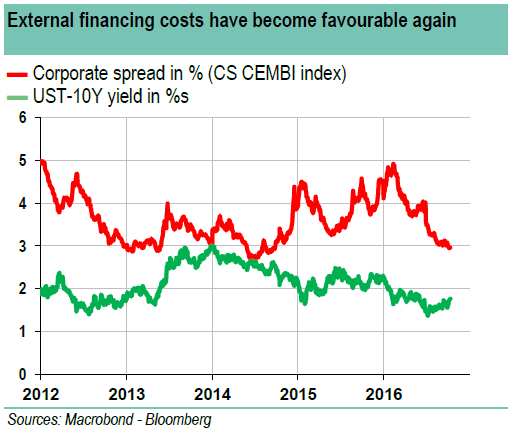The economic growth deceleration in emerging countries as a whole seems to have come to an end. Confidence indicators in the manufacturing sector have improved and external financing conditions have become very favourable. However, the recovery remains uneven and fragile. Beyond the fact that the Brazilian and the Russian economies are expected to emerge from recession, the recovery will remain constrained by the structural slowdown in world trade and the very gradual deleveraging of corporates.
The horizon brightens…
Economic growth in emerging countries seems to have hit bottom in late 2015. In real terms, aggregate GDP growth for our selection of 26 countries held at 4.1% in H1 2016. Growth was bolstered by a mild acceleration in the BRIC countries (which alone account for 36% of the total), to 5.1% in Q2 2016, from 4.5% in Q4 2015. Nonetheless, this stabilisation is fragile. First, the BRIC rebound is largely due to a milder recession in Russia and Brazil. Chinese growth barely levelled off at 6.7%, while India’s growth profile is still too jagged to talk yet of a turnaround. Second, many commodity exporting countries are still slowing (Andean countries; the Gulf countries) or have entered or are verging on recession (Saudi Arabia, Argentina, Nigeria and Angola). Lastly, growth is still solid in central Europe, but it has slowed since the strong acceleration of H2 2015, which was driven by the use of European structural funds.
And yet the short-term horizon is getting brighter. Confidence indicators in the manufacturing sector as a whole are looking more upbeat. Industrial deflation in China is easing. Credit has even accelerated slightly in central Europe. With the return of non-resident portfolio investment and the consolidation of commodity prices, external financing conditions have become as favourable as they were before the US Fed’s announcement of tapering in spring 2013 (see chart), while central banks’ foreign reserves are not under as much pressure.
… but growth forecasts remain in the dark
Growth forecasts by the international institutions have yet to take into account these easing headwinds. In its interim report released in late September, the OECD even revised downwards its 2017 growth outlook for the non-OECD world excluding Brazil, China and India by 0.2 percentage points (pp). The IMF left its outlook unchanged, although it raised its growth forecast for India by 0.2 pp. The OECD and IMF took a more in-depth look at two major constraints hindering the acceleration of growth in the emerging countries (in addition to the automatic impact of the stabilisation of the situations in Brazil and Russia): external trade weakness and corporate deleveraging.
The institutions recently published two in-depth studies on the world trade slowdown since the 2008-2009 financial crisis. World trade growth in goods and services has basically been slashed in half, from 8.5% in the period 2003-2007 to 4% in 2011-2015.

The slowdown even worsened in emerging countries in 2014-2015. The two institutions attempted to evaluate the contribution of cyclical and structural factors. Cyclical factors are still predominant (import demand for end goods, total or weighted by the component of demand in the IMF study; output gap, investment cycle and Chinese growth in the OECD study). But structural factors have also played a key role, notably the levelling off and decline in trade over the past two years linked to global value chains. This structural factor is clearly playing a primordial role in emerging Asia, based on the persistent sluggishness of the region’s exports (-2.4% in January-July 2016 compared to January-July 2015).
The IMF also highlights corporate deleveraging since 2015, based on gearing ratios (debt/capital) calculated for a selection of companies. Yet deleveraging will be a gradual process, even in a scenario of accelerating growth and today’s low refinancing costs, and some countries, like China and India, will continue to see a high share of debt-at-risk (i.e. the debt for which the coverage of interests by the EBITDA is less than 1). Corporate deleveraging might well be the second structural factor behind a milder recovery.
by François FAURE
